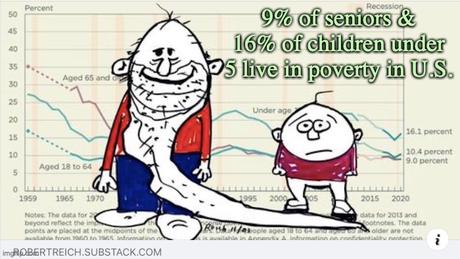
About 9% of seniors in the U.S. live in poverty. About 16% of children under 5 years old live in poverty. In a country as rich as the United States, neither of those facts should be true. But the numbers do pose a question -- why has this country done a mediocre job of dealing with poverty among the elderly, but a terrible job of dealing with poverty among young children?
Former Labor Secretary Robert Reich answers the question:
The current poverty rate among the elderly is 9 percent. That’s still too high, especially considering that our official measure of poverty understates the true level of hardship by failing to fully account for the high costs of housing.
But the current the poverty rate for children under 5 years old is over 16 percent. That, if I may say so, is an utter scandal.
The rate of child poverty in America hovered around 15 percent through most of the 1980s and early 1990s but worsened after 1996 when the Clinton administration (of which I was a member) joined Republicans in Congress to end a program called “Aid to Families with Dependent Children,” by then known as “welfare.” It had been part of the Social Security Act of 1935. I thought Clinton’s decision shameful then, and still do.
The Build Back Better bill that has passed the House (now awaiting Manchin’s and Sinema’s nods) extends the year-long child tax credit in last year’s Covid bill, thereby reversing Clinton’s decision — but not by much. The extension is for only one additional year. Had the tax credit been made permanent, as was Biden’s original intent, it would have cut child poverty by half.
America’s current rate of child poverty is among the highest of all advanced nations. We do have a Children’s Health Insurance Program, but it’s not close to what other advanced nations give their children. Hell, we don’t even provide what other advanced nations offer by way of childcare. Norway spends about $30,000 per child each year on early childhood care. Finland spends $23,000. Germany, $18,000. The United States? We spend $500 per child — or 1/60th of what Norways spends on its toddlers. As it stands now, Biden’s Build Back Better bill will provide additional funding. But it’s astonishing how little the richest nation in the world has done for its kids.
Let’s be clear: Poverty is a political choice.
So why have we chosen to reduce poverty among America’s elderly but not among America’s children? There are three dominant theories:
Because the elderly vote and children don’t. Many have suggested this, but it can’t be the reason because children have parents and grandparents who do vote.
Because of racism, in that a disproportionate percent of poor kids are children of color. This is a common explanation as well, but it also falls short because a disproportionate percent of the elderly poor are also people of color.
Because of demographics, in that the giant boomer generation is intent on keeping or expanding Social Security and Medicare. The timing doesn’t quite work, in that America was most generous to the elderly way before boomers got old. Besides, boomers have grandkids.
So what’s the answer? My guess is that we as a society were simply more generous to those in need during the 1960s and 1970s, because those were years when the middle class was expanding, and most Americans were doing better. These were the years when we created Medicare and expanded Social Security, and provided a lot of assistance to poor children through Aid to Families with Dependent Children.
But we’re not as generous now. Even though the American economy is far larger than it was then, the middle class is a smaller share of it. For the last four decades America has been dividing into well-off professionals who don’t feel any connection to the poor, and a beleaguered working class that’s easily convinced any help to the poor will cause their taxes to increase.
Hence, in 1996 even a Democratic president decided to end aid to poor kids, largely because polls showed that most Americans — including the vast majority of the working class — no longer supported welfare. Twenty-five years later — and even after the awful consequences of that decision have become apparent — a Democratic Congress has chosen not to provide permanent help to the nation’s poor kids.
In other words, I don’t think we’ve prioritized the elderly poor over poor children. The big difference is we have become far less equal as a society, which has made us less willing to remedy poverty at all.

